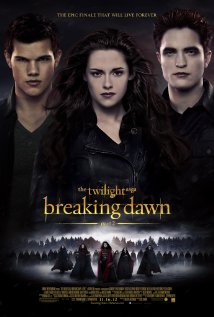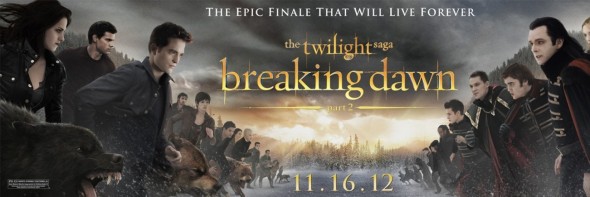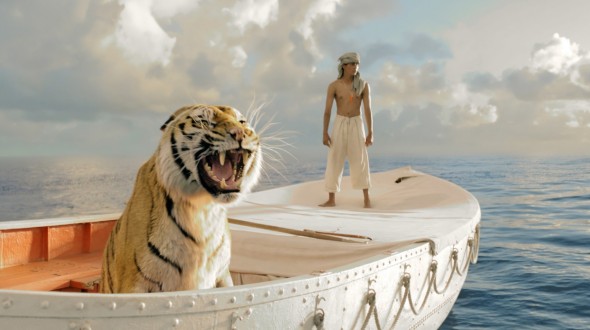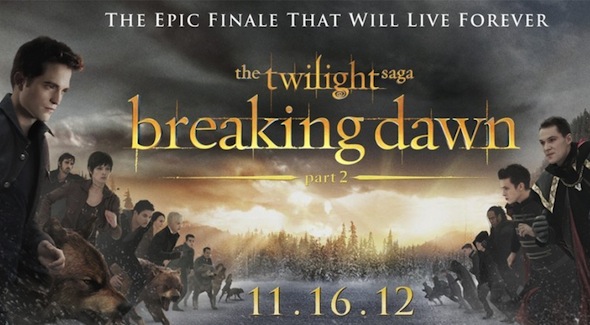[ATTENTION READERS! This is a SPOILER ALERT for Life of Pi and Twilight: Breaking Dawn Part 2. I will discuss the ending of both of these books/movies in this post.]

Brechting Dawn.
I recently had the pleasure of seeing Twilight: Breaking Dawn Part 2 in the theater recently. No, I don’t mean that sarcastically. Even though I’m far from a Twilight fan, I actually enjoyed the experience. Here’s why: this movie and its twist ending offers an excellent opportunity to explore the concept of the Distancing Affect, Verfremdungseffekt, or, as we like to call it here on Overthinking It, Brechtian Alienation.
Scary terminology, I know. Let me break it down for you. Most of the time, when watching a movie, TV show, or play, we, the audience, are meant to experience the narrative as if we are direct observers of events. In the case of movies and TV, we see what the camera sees, but we’re not thinking in terms of actors and cameras; we’re thinking strictly in terms of the story that we’re seeing unfold before our eyes. When we see the Death Star blow up, we surrender ourselves to the story, and we celebrate along with Luke, Han, and the Ewoks.
Other times, though, a movie, TV show, or play breaks out of simple narrative storytelling and intentionally reminds us of the fact that we’re observing a contrived setup of actors, lines, lights, and cameras. Sometimes it’s a jarring breaking of the fourth wall, when a character directly addresses the audience. Other times, it’s a more subtle reminder of the contrivance, such as blood splattering on a camera lens.
Why is there a camera lens to be splattered upon in this bloody dismemberment scene? Oh, right. Because this is just a movie, not an actual bloody dismemberment scene. It’s called “alienation” because in these moments, we are separated from what is otherwise an immersive, intimate relationship with the story.
(As for the “Brecht” part of “Brechtian Alienation,” all you need to know is that Bertolt Brecht was a German playwright and the first person to articulate this theory. And that using the phrase “Brechtian Alienation” is both easier to spell than “Verfremdungseffekt” and more impressive-sounding than “distancing effect.”)
That’s the “what” of Brechtian Alienation. We’ll get to the “why” in a moment, but first, we describe the intense moment of alienation in Twilight: Breaking Dawn Part 2 (which I will subsequently abbreviate as TBD2, because let’s be honest: it’s the second most ridiculous name in this movie after “Renesmee,” but not by much).
(Oh, and, last spoiler alert for TBD2!)
In the closing act of TBD2, we see the two opposing vampire groups gather for the climactic showdown. Alice, the clairvoyant vampire, attempts to reason with the Volturi, who have come to kill Edward and Bella’s daughter, Renesmee. Alice fails, and all hell breaks loose. Major character after major character die, often in dramatic fashion, including the Big Bad himself, Aro, at the hands of Edward and Bella.

BTW, this banner ad looks an awful lot like promo material for “The Dark Knight Rises.” Can someone get on a Bane/Twilight mashup, pronto?
Except not. As Aro dies, the camera flashes back to the point where Alice is trying to reason with Aro. It turns out that the epic battle was all in their heads. The events that we, as an audience, had just seen and accepted as true were all just part of Alice’s vision of the future, and Aro, having seen that vision, decided against a course of action that would have brought about his demise. The Volturi depart without a fight.
Why did we just buy into twenty minutes of intense action and death-by-decapitation, only to be told that none of this actually happened? Oh, right. Because this is just a movie, not an actual tense vampire stand-off in the forest.
This is as alienating as, if not more than, a breach of the fourth wall. We all know that movies are manipulative; that cinematic storytelling, with all of its swelling music and slow motion, manipulates us into having strong feelings for a fictional, constructed, made-up story. But we don’t think about this while being manipulated; we let ourselves be manipulated because we surrender ourselves to the story, at least until the lights come up. The sudden reversal of events in TBD2 jerks the audience out of the story and reminds us of the manipulation at hand in a way that is supremely alienating. It creates miles of distance between the audience and the story.
Brecht would be proud.

Coming soon to the OTI store: “Team Bertolt” t-shirts
Or would he? Let’s get down to the “why” of Brechtian Alienation. We’ve just established that sometimes storytellers intentionally create distance between the audience and the story by calling into attention the constructed nature of the medium. But why would they do such a thing? Wouldn’t doing so cheapen the effect of the story that they’re trying to sell to the audience?
Not necessarily. Brechtian Alienation is meant to make the audience step back and appreciate the constructed quality of a story, ideally in a way that highlights the ideas that the author is trying to communicate. Take, for example, another highly anticipated movie adaptation of a novel that recently hit theaters: Life of Pi. The bulk of the movie is spent telling the story of how a young man survives on a lifeboat with a Bengal tiger for 227 days. However, at the end, the movie strongly suggests that these events may not have happened at all and that the narrator fabricated the tiger story to mask the darker true story, one that involved the murder of three other human passengers on the lifeboat, including his mother.
As was the case in TBD2, the reveal of this ambiguity is intensely alienating. After the emotional investment in the story of the unlikely bond that slowly develops between the tiger and the narrator, we are yanked out of that story and presented with the possibility that those events didn’t happen at all. But this isn’t done just to mess with the audience; it’s done to advance the central idea of Life of Pi, which is that sometimes the beauty and strength of a story is not simply a function of how true or untrue it is. (Also, something about proving that God exists, but I didn’t totally wrap my mind around that. Moving on!)

Coming soon to the OTI store: “Team Richard Parker” t-shirts
The act of Brechtian alienation is essential to communicating the core idea of Life of Pi to the audience. Can we say the same thing about TBD2, and Twilight writ large? That depends on what you think the core idea of Twilight is. If you think it’s “love conquers all,” then no, Brechtian alienation doesn’t help at all. Allowing the audience to put critical distance between itself and the love story only serves to remind the audience how over-the-top and unrealistic the love story is.
But if you think the core idea of Twilight is growing up from adolescence into adulthood, then we may be onto something. During the course of the Twilight series, Bella transformed from an awkward teenage girl into an immortal vampire woman and mother. Likewise, during the course of Twilight’s transition from book to screen, the movies started as excruciatingly awkward and low budget affairs but eventually grew into something that could more plausibly stand on its own as entertainment. But for the movies to really make it to “adulthood,” they had to move beyond the “adolesecence” of the storytelling constraints of the books. And what better way to do that than by employing Brechtian alienation to defy audience expectations and call attention to the constructed, filmic, decidedly non-book-like nature of the climax to the last movie?
You can call it a stretch, but I honestly think there’s some plausibility to this theory. Director Bill Condon is far from an unsophisticated filmmaker; he wrote or directed three Oscar winners: Gods and Monsters, Dreamgirls, and Chicago. The guy may not have always have Verfremdungseffekt on the mind, but he certainly knows what gets an audience to surrender to a story versus what alienates an audience from a story.
I’m only willing to go so far in my justification for the Brechtian Alienation in this movie. It’s interesting and thought-provoking (as these 1,400 words and references to Life of Pi would indicate), but not so masterfully executed that I can praise it. It didn’t feel good to be jerked out of the story so abruptly. As a result of this alienation, I did feel a little bit cheated/disrespected as an audience member, and based on the reviews on IMDB.com, it seems many others felt the same way.
But in the spirit of Brecht, I did take advantage of this moment of alienation from the story to dispassionately assess the creative work from a distance, and for that, I am glad that I saw this movie. Did you? If so, I hope you’ll join in this alienated discourse and share your distanced thoughts in the comments.

My wife’s a bit of a Twi-Hard and we saw the movie last week.
You mention that “[Condon] certainly knows what gets an audience to surrender to a story versus what alienates an audience from a story.” I’m not sure if there were any other fans of the book in the audience with you. But when the fight sequence went down and characters started dying, there was a very palpable change of mood in the theater. People were visibly upset. There were screams. When the premonition faded, there were cheers.
No matter what Condon did, no one was going to surrender to his version of the story. The primary audience had already been captured, and was being held in a Stephanie Meyer POW Camp. The fight sequence seemed to me to be a bit of a ham-handed attempt to add action to a closure sequence that was desperately lacking it. Any minimal gains came at the extreme displeasure of the core followers.
Maybe this is a little less Brecht and a little more Dallas?
“I’m not sure if there were any other fans of the book in the audience with you. But when the fight sequence went down and characters started dying, there was a very palpable change of mood in the theater. People were visibly upset. There were screams. When the premonition faded, there were cheers.”
Tough to say. The theater I saw it in was less than half full. I didn’t hear any reactions to the characters’ deaths during the battle scene, but at the moment of the reveal, there was definitely an outburst of some sort. I wouldn’t call it cheering; it was more of a combination of laughter and “Whaaa?”
I had the opposite experience at my screening; upon the big reveal, the audience unmistakably and collectively groaned in a “you’ve got to be kidding me!” moment.
Doesn’t the scene need to engage its audience at a meta-level for Brechtian alienation to work? For fanpeople, I think the fight scene was a thrill of surprise, of not knowing where the movie is taking their beloved story. They were certainly entertained by that (Brechtian?) alienation – if not by the action itself.
But the Twilight movie is also catering to a second audience- one that hadn’t read all the books or followed the story so far, but came in to see a good movie. The question is, was this group entertained by the surprise ending?
I and my friends unanimously said “no”. We had totally invested in the scene at face value. We did not know what was coming. Maybe there were some tip-offs: over-the-top violence, the glee with which even the good guys indulged in decapitations… but the director never managed to crack the fourth wall enough to make it worthwhile. It wasn’t Brechtian alienation, it was “I just wasted 20 minutes of my life on this poop” alienation.
anyone who went to see Twilight “to see a good movie” was clearly in the wrong theater. or had unrealistic expectations. and I like them, but that doesn’t mean I’m not well aware of their flaws.
Sure, but as a moviegoer you go in with certain expectations, no matter what your reason for watching a movie might be(keeping up with the popular discourse, pleasing a significant other, masochistic tendencies…) You’re about to spend two hours and $10+ on an unknown enterprise, and you want it to be entertaining, informative and inspiring. Or at the very least, to not suck. I’m wondering where TBD2 managed to fall on that spectrum for different people.
It’s an interesting observation about alienating the audience. But I really don’t think that was the intention of TBD2. The major flaw in the book was that there was a whole lot of build up to everyone standing around in a field talking. Stephenie Meyer and Melissa Rosenberg had to figure out how to handle that cinematically and from what I heard they were sitting around at coffee one day when they came up with the idea of utilizing Alice’s visions to increase the action and the pay off without betraying the book. And in that regard, I think they did it really well. I think it was a narrative device of the writers more than a cinematic device of the director.
But it’s a really good point in Life of Pi.
Not that it changes the analysis of Brechtian alienation much, but video interviews with the cast/director/author suggest that the surprise ending was the screenwriter Melissa Rosenberg’s idea and was first discussed during a dinner with Stephenie Meyer. Meyer really liked the idea and helped Rosenberg conceptualize the fight sequence.
I read those “gasps” in the theater a little differently than the above respondent. Yes, I think the gasps early in the action sequence are real gasps of WFT; they force the Twi-fan to ask if they can believe what they’re seeing. 5+ hours of film saga that stay religiously faithful to the books makes you complacent that the movies will remain religious to the books. But as the fight sequence becomes increasingly intense and more seminal characters are killed off, I’m guessing that most folks in the theater started to sense an unsustainable level of carnage and absurdity. By the end of the fight sequence, I already had a strong hunch that we were seeing Alice’s vision. I’m sure I wasn’t alone. Thus, I read the final cheers as cheers of “Ah, we were right! We know the Twi-world as well as we think we do. We are indeed in Alice’s vision.” This, of course, makes the Brechtian alienation effect even stronger and more pronounced.
I further support this reading by TBD2’s unapologetic failure to explain anything about the Twi-universe to anyone who’s missed the last few movies or books. Granted, the Twi-verse is a confusing and ontologically loosey-goosey place even on a good day and to the most meticulous fan–but at least in the other four films, there were clear gestures toward catching up people who had no idea WTH was going on because they’d missed the last few books or movies. TBD2 makes no such apologies. A non-fan would be left wondering “Why are these little Native American kids turning into wolf cubs like popcorn kernels popping into popcorn? Why is nobody worried about the wolf that Bella just flailed against a tree and clearly injured? Why is it suddenly so easy for Bella to not eat her own father when 24 hours ago, she could barely keep herself from eating a hiker? What exactly is Aro’s superpower and why is everyone so afraid of him? When he touches someone’s hand, how much information does he get? Why does Alice instruct Bella to burn J. Jenks’ name? Why is Alice walking slowly out of the woods like a boss, seemingly totally unafraid of Aro?” And so on and so forth. This is, of course, to say nothing of the inconsistencies of the Twi-world that ANY fan wonders about–like why it’s considered sufficiently safe for Bella, who grew up in the small town of Forks so everyone knows what she looks like and would probably like to speak to her again, to venture out to Charlie’s house in vamp mode with a child that grows unusually quickly.
Frankly, I wonder if the ending wasn’t a financial/logistic decision. Let’s face it, the original ending in BD2 is not very visually compelling. As originally written, there would be almost nothing in this film worth seeing twice because it was all so straightforward (unlike in Breaking Dawn 1, where there are dozens of scenes that chicks would gladly watch over and over again–like a wedding and two bedroom scenes). I suppose they could have shown more of Bella’s fight training, but that would have been awfully reminiscent of the fight training in Eclipse. The big final fight sequence gives fans some incentive to come back to TBD2 before the DVD release, thereby giving this film more staying power across several weeks.
How does this compare to, say, the Final Destination movies, which all open with a set of ‘this action sequence didn’t actually happen’?
And I’m also reminded of a particular Nicholas Cage movie which also pulled the ‘this action sequence was just a possible outcome’ schtick.
By the way, this is what I was referring to when I said the Twilight banner ad looked very similar to something I saw for The Dark Knight Rises:
http://wac.450f.edgecastcdn.net/80450F/screencrush.com/files/2012/05/tdkr-standoff.jpg
Goodness, that’s a gorgeous banner ad.
It worked at the cinema that I was in. Like slims above, you could pick the people who were fans of the books, because they were starting to get visibly upset during the fight scene.
You could also pick the tag-alongs. We were the people upset when the death of Aro wasn’t followed with credits.
What a fantastic ending that would have been.
Either way, the jarring jolt back to the story made every person in the cinema react in some way – something that you rarely see lately, where most cinema follows a standard story or plot so devotedly that it gets predictable and dull.
But for me (and the people I went with) it has to be typified by the girl sitting three rows back – who reacted to the reveal with “Are you f***ing serious?!?” That lightened the mood of the whole cinema, who instantly burst out laughing.
Well, actually, an incident of brechtian alienation is not meant to be entertaining. Quite the opposite, actually. It is supposed to be a rude awakening from the escapistic slumber that is the exploitative world of consumption and entertainment. It is a bit elitist or esoteric, as one has to have been initiated to the concept before one can understand it. One who is entertained by the Verfremdungseffekt or sees it merely as a stylistic choice without any meta-level substance, is streets behind.
A text with brechtian elements is supposedly intended to be an intellectual excercise instead of a frivolous pastime. Here, one has to assume the author’s intent in the creation of the text. It is, however, completely possible that brechtian elements have been inserted casually or by chance, and that the author is thus merely failing forward, so to speak. This ambiguity between narrative incompetence and competent narrative esoterism makes texts like TBD2 (and texts like Fight Club, the Final Destinations, Sucker Punch, Total Recall and the Ghostbuster 2 logo and soo many other things) such fertile grounds for the crop that is pedantic overthinking.
Understanding the Verfremdungseffekt is taking the red pill, and seeing how deep the rabbit hole goes.
I learned to love the Twilight films when I learned to understand them as a story of growing from adolescense to adulthood. As a non-vampiric and non-lycanthropic member of the male sex, a demo which was horribly under-represented in the franchise btw, I had few relatable charachters in the saga. This was not a problem, as Bella was a blank slate of a character, a Gordon Freeman, if you will.
The actual process of growing from adolescence to adulthood in the real life was masterfully reconstructed and re-presented in the Twilight saga, as real life too is absurd, poorly narrated, unevenly paced, needlessly sentimental, scatterd with body horror, filled with one-dimensional characters and ultimately harbouring a conservative message on the necessity of repression and illusion. Kudos for that, I guess. All, that can be read into Twilight ended there by accident, I assume.
Therefore, it’s just a big blue pill.
Can’t get enough of that dog face painting, though.